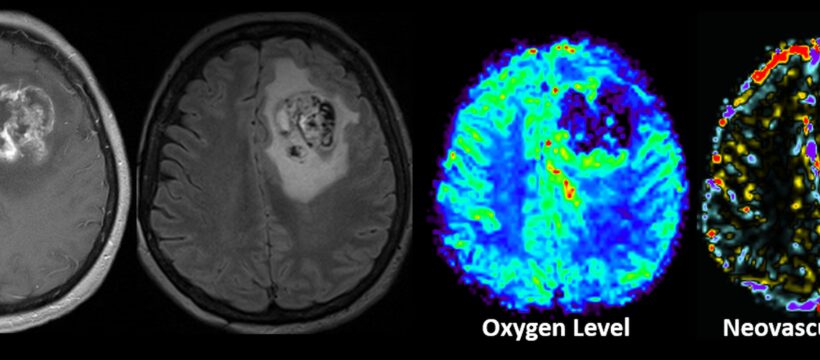Study by Karl Landsteiner University for Health Sciences demonstrates partial superiority of artificial intelligence and physiological image data in brain tumor classification
Krems (Austria), 21. June 2022: The classification of brain tumors – and thus the choice of optimal treatment options – can become more accurate and precise through the use of artificial intelligence in combination with physiological imaging. This is the result of an extensive study conducted by the Karl Landsteiner University for Health Sciences (KL Krems). Multiclass machine learning methods were used to analyze and classify brain tumors using physiological data from magnetic resonance imaging. The results were then compared with classifications made by human experts. Artificial intelligence was found to be superior in the areas of accuracy, precision and misclassification, among others, while professionals performed better in sensitivity and specificity.
Brain tumors can be easily detected by magnetic resonance imaging (MRI), but their exact classification is difficult in this way. Yet that’s precisely what’s crucial for choosing the best possible treatment options. Now, an international team led by KL Krems has used data from modern MRI methods as the basis for machine learning (ML) protocols and assessed the use of artificial intelligence to classify brain tumors. They found that in certain areas, classification using artificial intelligence can be superior to that performed by trained professionals.
More MRI. More Data.
The team led by Prof. Andreas Stadlbauer, a scientist at the Central Institute for Medical Radiology Diagnostics at St. Pölten University Hospital, used both advanced and physiological MRI data for the study. Both methods provide enhanced insight into the structure and metabolism of a brain tumor and have allowed better classification for some time. But the price to pay for such a differentiated picture is enormous amounts of data that need to be expertly assessed. „We have now analyzed whether and how an artificial intelligence using ML can be enabled to support trained professionals in this Herculean task,“ explains Prof. Stadlbauer.“And the results are very promising. When it comes to accuracy, precision and avoiding misclassification, an AI can classify brain tumors well using MRI data.“
To achieve their impressive result, the team trained nine well-known Multiclass ML algorithms with MRI data from 167 previous patients who had one of the five most common brain tumors and had accurate classification using histology. A total of 135 so-called classifiers were generated in a complex protocol. These are mathematical functions that assign the material to be examined to specific categories. „In contrast to previous studies, we also took into account data from physiological MRIs,“ explains Prof. Stadlbauer. „This included details on the vascular architecture of the tumors and their formation of new vessels, as well as the supply of oxygen to the tumor tissue.“
Radiophysiomics
The team named the combination of data from different MRI methods with multiclass ML „radiophysiomics.“ It’s a term that’s likely to catch on quickly, as the potential of this approach became apparent in the second part of the project, the testing phase. In this, the now-trained multiclass ML algorithms were fed with corresponding MRI data from 20 current brain tumor patients and the results of the classifications thus obtained were compared with those of two certified radiologists. Thereby, the two best ML algorithms (referred to as „adaptive boosting“ and „random forest“), outperformed the human assessment results in the areas of accuracy and precision. Also, these ML algorithms resulted in less misclassification than by the professionals (5 versus 6). On the other hand, when it came to the sensitivity and specificity of the assessment, the human assessments proved to be more accurate than the AI tested.
„This also makes it clear,“ says Prof. Stadlbauer, „that the ML approach should not be a substitute for classification by qualified personnel, but rather a supplement to it. In addition, the time and effort required for this approach is currently still very high. But it offers a possibility whose potential should be further pursued for everyday clinical use.“ Overall, this study again demonstrates the focus of research at KL Krems on fundamental findings with real clinical added value.
Original Publication: Radiophysiomics: Brain Tumors Classification by Machine Learning and Physiological MRI Data. A. Stadlbauer, F. Marhold, S. Oberndorfer, G. Heinz, M. Buchfelder, T. M. Kinfe & A. Meyer-Bäse. Cancers 2022, 14, 2363. https://doi.org/10.3390/cancers14102363
About Karl Landsteiner University of Health Sciences (2022)
At Karl Landsteiner University of Health Sciences (KL) in Krems, the comprehensive approach to health and disease is a fundamental objective for research and teaching. With its Europe-wide recognized bachelor-master system, KL is a flexible educational institution that is tailored to the needs of students, the requirements of the labor market as well as the scientific challenges. Currently KL hosts about 600 students in the fields of medicine and psychology. The four university hospitals in Krems, St. Poelten, Tulln and Eggenburg ensure clinical teaching and research at the highest quality level. In research, KL focuses on interdisciplinary fields with high relevance to health policy – including medical technology, molecular oncology, mental health and neuroscience, as well as water quality and related health aspects. KL was founded in 2013 and accredited by the Austrian Agency for Quality Assurance and Accreditation (AQ Austria). www.kl.ac.at/en
Scientific Contact
Prof. Dr. Andreas Stadlbauer
Institute of Medical Radiology Diagnostics
University Hospital St. Pölten
Karl Landsteiner University of Health Sciences
3500 Krems / Austria
T +43 2742 9004-14198
E andreas.stadlbauer@stpoelten.lknoe.at
Karl Landsteiner University of Health Sciences
Ingrid Brunner
Communications, PR & Marketing
Dr.-Karl-Dorrek-Straße 30
3500 Krems / Austria
T +43 2732 72090 234
E ingrid.brunner@kl.ac.at
W http://www.kl.ac.at/
Copy Editing & Distribution
PR&D – Public Relations for Research & Education
Dr. Barbara Bauder
Kollersteig 68
3400 Klosterneuburg / Austria
M +43 664 1576350
E bauder@prd.at

